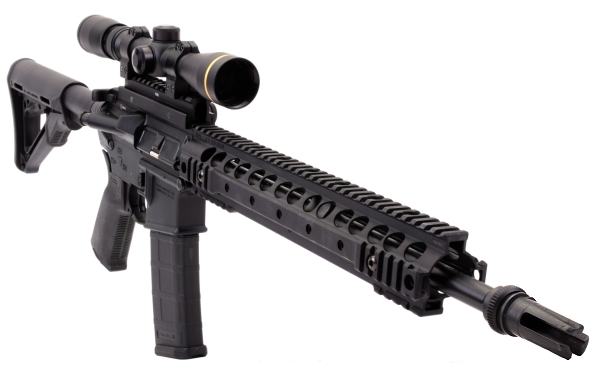
It is tough to write about acronym firearms, uppers and accessories. The hardware can be exceptional, as can be the performance, but a vocal 5% component of the culture and press surrounding these types of firearms carries on like teenage girls at a Katy Perry concert. As a guy with granddaughters, that isn’t a vague reference. This 5 percent creates drama and celebrity where none is warranted, they chase trends without purpose or real world application, and they popularize machinery with no logical foundation. But then there is the other 95%…
We’ve expended some shop time in recent years working with various 300 Blackout chambered firearms, but stopped short of allocating time to publish reviews because the public dialogue surrounding this cartridge and firearms was often… silly and because social media was flooded with companies substituting marketing hype and/or theoretical scenarios in place of factual data in an effort to sell products. Two events finally provided enough motivation to put something together.
In conversation, a solid industry type concluded that the 300 Blackout could be configured to shoot accurately supersonic or subsonic, but not both; which contradicted personal experience. The second was a digital publication article that was so factually incorrect it seemed that the author was being malicious or had never actually seen much less shot the indicated product. Troubling, as it only takes a firearm, some ammo, targets, and a chronograph to produce accurate information. So…
300 AAC Blackout history…
As the development history of the 300 Blackout won’t alter a chronograph reading, or serve to tighten or spread the holes in a target, responsibility for telling that story has been left to the very few knowledgeable writers who did the research with integrity. An excellent synopsis of the 300 Blackout’s development and preexisting cartridge associations was done by Steve Johnson in his November 2012 American Rifleman article. An excellent source of information regarding the 300 Advanced Armament Corp’s Blackout cartridge and Low Visibility Carbine is designer Robert Silvers’ 2012 defense industrypresentation. If you decide to dig further, you might research Silvers’ technical design and process contributions to AAC and skip the founder’s vitriolic statement unless you’re a fan of tantrums.
The 300 Blackout… Context is everything
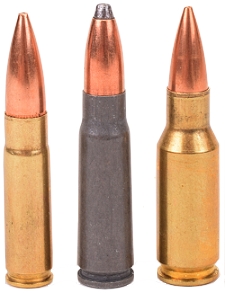
Pictured left to right, the 300 Blackout, the 7.62×39 Russian and the 30 Remington AR.
| Cartridge | Pmax PSI |
Case Grains |
Case Length” |
COL “ | Case Body Dia. “ |
Rim Dia. “ |
Intro Year |
| 300 Blackout | 55,000 | 25.1 | 1.368 | 2.260 | 0.376 | 0.378 | 2009 |
| 300 Whisper | 50,763 | 25.0 | 1.374 | 2.224 | 0.376 | 0.378 | 1992 |
| 7.62x39mm | 51,488 | 35.6 | 1.524 | 2.205 | 0.447 | 0.447 | 1944 |
| 30 Rem AR | 55,000 | 44.0 | 1.530 | 2.260 | 0.500 | 0.492 | 2009 |
| 5.56 NATO | 62,366 | 28.5 | 1.760 | 2.260 | 0.377 | 0.378 | 1957 |
| 7.62 NATO | 60,191 | 52.0 | 2.015 | 2.800 | 0.471 | 0.473 | 1954* |
| *NATO Standard – 1945 U.S. Origin – 1957 U.S. Military Standard | |||||||
Four of the more popular 30s that find their way into AR15 size/capacity firearms with 5.56 NATO and 7.62 NATO standards included for the sake of comparison.
There isn’t much performance difference amongst the 300-221 Fireball, 300 Whisper and 300 AAC Blackout cartridges other than descriptive bias. The 300-221 Fireball is a wildcat derivative of the 1962 .221 Remington Fireball, intended for use in bolt and break action pistols used in silhouette shooting competition; inventor unknown. The 300 Whisper is the name trademarked progeny of J.D. Jones and SK Industries; a copy of the 300-221. The 300 Blackout is the creation of Advanced Armament Corp’s Robert Silvers, its case is based on the 300 Whisper and 300-221 with the intent of gaining SAAMI homologation and permitting specification control separate from these other related cartridges.
The project rifle…

A 16″ 300 AAC Blackout MPW rifle produced in Lawrenceville, GA was used for cartridge assessment within this project. Since this firearm’s production, the company has moved to its parent company’s Huntsville, AL facility and the MPW is no longer offered as a complete firearm. AAC, however, does offer 300 Blackout uppers in 9″, 12.5″ and 16″ versions, with a $1,079.99 MSRP that pin to any spec lower with the correct extension, buffer spring and buffer.
Since the 300 Blackout cartridge is by design compatible with the standard 5.56 NATO bolt and magazines, another option is to purchase a AAC barrel in the same length that are shipped complete with gas block and gas tube. The MSRP is $424.99. Barrels, gas blocks and tubes are available from many quality suppliers, sold at a substantially lower price.
AAC barrels installed on an assembled rifle or upper, or purchased as a component, are made of 4150 steel with bore, chamber and exterior finished in black nitride. Twist rate is 1:7″. Muzzle end threads are 5/8″-24 with complete firearm and assembled uppers receiving an AAC 51 tooth Blackout flash suppressor.
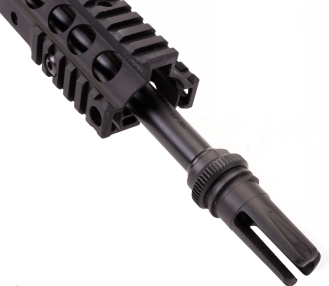
The complete AAC rifle, or upper, is fitted with a Knight’s Armament aluminum URX III handguard. The handguard top rail continues seamlessly from the flat top rail to the end of the handguard. Accessory short rails are located on the handguard at 3, 6 and 9 o’clock positions.
The AAC bolt carrier group is nickel boron coating for hardness and reduced friction. A base layer of high-phosphorous electroless nickel provides exceptional protection against corrosion. The bolt is manufactured from Carpenter 158 steel, shot-peened to prevent hydrogen embrittlement in critical lug areas. A special green o ring that can withstand -40º F without binding is standard. The extractor spring is a low fatigue design to ensure the longest possible life. The extractor pin made from durable 300 ksi S2 tool steel.
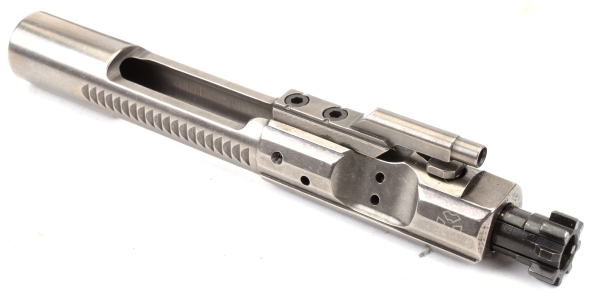
The complete MPW was supplied with a Geissele trigger. The collapsible stock and pistol grip and 30 round magazine are all MagPul pieces. At just over 6 1/2 Lbs the MPW is a light and fast handling and nicely finished firearm. A Leupold scope was installed on the rifle pictured left, as it was being checked for accuracy.
A quick run through…
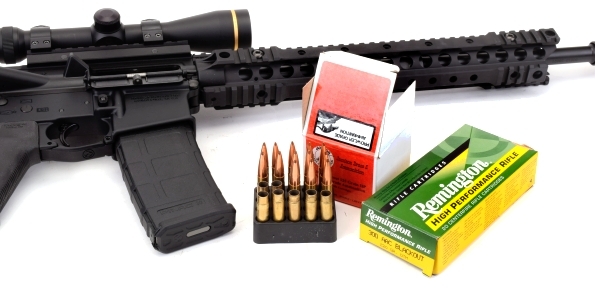
With two types of factory ammo on hand, and the day coming to a close, Jamison 125 grain HP Prowler Grade Ammunition, rated at 2,130 fps fired from a 16″ barrel, clocked 2,054 fps over the chronograph. Remington High Performance 220 Grain Open Tip Match, rated at 1,050 fps came in at 1,136 fps. I only had time for one target with Jamison ammo as posted below. From a boresight it took three shots to walk vertically to the bullseye before shooting this 7/8″ center to center 5 shot group. Both Jamison and Remington OTM ammo utilized Sierra MatchKing bullets. I ran out of time before I had a chance to take an accuracy read on Remington ammo, but that will be included in Part II along with select handloads.
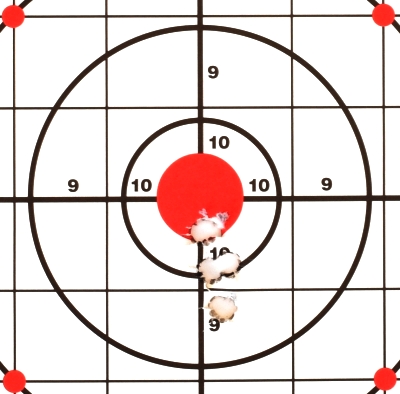
From the vantage point of exterior ballistics, the Jamison and Remington ammunition look as indicated on the tables below –
| 125 Grain Jamison Ammunition | |||||||
| Yards | 0 | 50 | 100 | 150 | 200 | 250 | 300 |
| Velocity – fps | 2054 | 1942 | 1833 | 1728 | 1628 | 1534 | 1445 |
| Energy – ft.-lbs. | 1171 | 1046 |
933 | 829 | 735 | 653 | 580 |
| Momentum – lbs-sec | 1.14 | 1.07 | 1.01 | 0.96 | 0.90 | 0.85 | 0.80 |
| Path – in. | -1.5 | 1.9 | 3.0 | 1.5 | -2.9 | -10.6 | -22.0 |
| Drift – in. | 0.0 | 0.0 | 0.0 | 0.0 | 0.0 | 0.0 | 0.0 |
| Time of flight – sec. | 0.0 | 0.1 | 0.2 | 0.2 | 0.3 | 0.4 | 0.5 |
|
Best Zero Results |
|||
|
Near-Zero Yards |
18 |
Midrange Yards |
97 |
|
Far-Zero Yards |
171 |
Max Ordinate “ |
+3.0 |
|
Point-Blank Yards |
201 |
|
|
|
220 Grain Remington Ammunition |
|||||||
|
Yards |
0 |
50 |
100 |
150 |
200 |
250 |
300 |
|
Velocity – fps |
1136 |
1110 |
1085 |
1063 |
1042 |
1024 |
1006 |
|
Energy -ft.-lbs. |
630 |
601 |
575 |
552 |
531 |
512 |
494 |
|
Momentum -lbs-sec |
1.11 |
1.08 |
1.06 |
1.03 |
1.01 |
1.00 |
0.98 |
|
Path – in. |
-1.5 |
2.9 |
0.3 |
-9.7 |
-27.4 |
-53.1 |
-87.1 |
|
Drift – in. |
0.0 |
0.0 |
0.0 |
0.0 |
0.0 |
0.0 |
0.0 |
|
Time of flight- sec. |
0.0 |
0.1 |
0.3 |
0.4 |
0.6 |
0.7 |
0.8 |
|
Best Zero Results |
|||
|
Near-Zero Yards |
10 |
Midrange Yards |
57 |
|
Far-Zero Yards |
102 |
Max Ordinate “ |
+3.0 |
|
Point-Blank Yards |
121 |
|
|
You might look at the table above and think, “Why would I want something like this?”. In his presentation, Mr. Silvers positions the 300 AAC Blackout Low Visibility Carbine as a replacement for the MP5-SD3 by stating it has 3x the range. The MP5-SD3 is a Heckler & Koch HK MP5SD Suppressed Submachine Gun, introduced in 1974 and chambered for the 9mm Parabellum. Its performance is a 115 grain bullet with 900 fps MV and 6 – 9 MOA 100 meter accuracy.
The MP7 is another H&K suppressed submachine gun only chambered for the more specialized, miniscule 4.6x30mm. it’s maximum range is inside 200 meters and its claim to fame is piercing body armor. With the exception of the armor piercing capability, the 4.6x30mm has about the same terminal ballistics as the 9mm Parabellum. Bullets for the 4.6 are 0.183″ in diameter with a typical weight of 30 or 40 grains depending on bullet core material and intended application.
We’re going to take a break here and get on with Part II preparation.
Advanced Armament Corps 300 Blackout Part 1
Advanced Armament Corps 300 Blackout Part 2

Email Notification